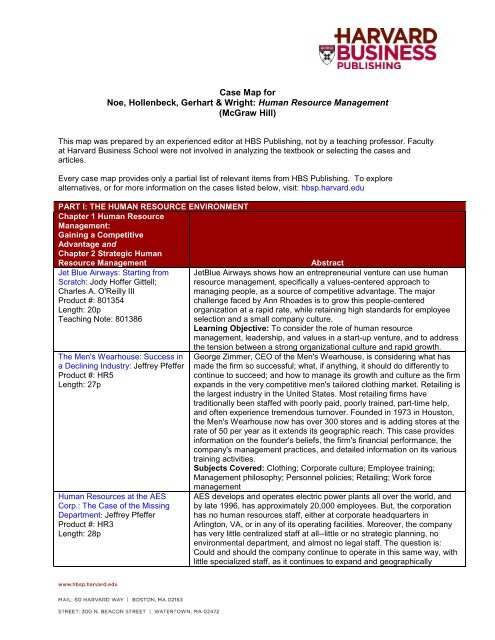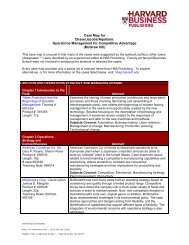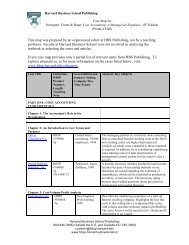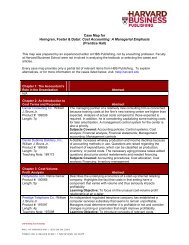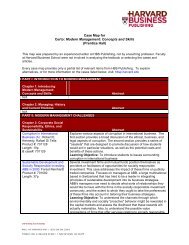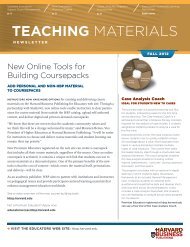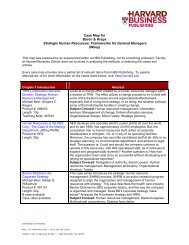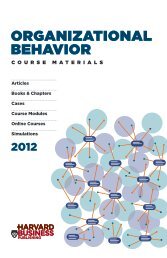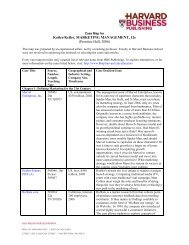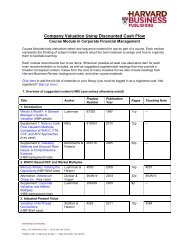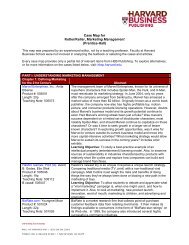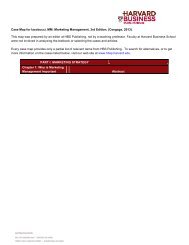Case Map for Noe, Hollenbeck, Gerhart & Wright - Harvard Business ...
Case Map for Noe, Hollenbeck, Gerhart & Wright - Harvard Business ...
Case Map for Noe, Hollenbeck, Gerhart & Wright - Harvard Business ...
You also want an ePaper? Increase the reach of your titles
YUMPU automatically turns print PDFs into web optimized ePapers that Google loves.
<strong>Case</strong> <strong>Map</strong> <strong>for</strong><br />
<strong>Noe</strong>, <strong>Hollenbeck</strong>, <strong>Gerhart</strong> & <strong>Wright</strong>: Human Resource Management<br />
(McGraw Hill)<br />
This map was prepared by an experienced editor at HBS Publishing, not by a teaching professor. Faculty<br />
at <strong>Harvard</strong> <strong>Business</strong> School were not involved in analyzing the textbook or selecting the cases and<br />
articles.<br />
Every case map provides only a partial list of relevant items from HBS Publishing. To explore<br />
alternatives, or <strong>for</strong> more in<strong>for</strong>mation on the cases listed below, visit: hbsp.harvard.edu<br />
PART I: THE HUMAN RESOURCE ENVIRONMENT<br />
Chapter 1 Human Resource<br />
Management:<br />
Gaining a Competitive<br />
Advantage and<br />
Chapter 2 Strategic Human<br />
Resource Management<br />
Jet Blue Airways: Starting from<br />
Scratch: Jody Hoffer Gittell;<br />
Charles A. O'Reilly III<br />
Product #: 801354<br />
Length: 20p<br />
Teaching Note: 801386<br />
The Men's Wearhouse: Success in<br />
a Declining Industry: Jeffrey Pfeffer<br />
Product #: HR5<br />
Length: 27p<br />
Human Resources at the AES<br />
Corp.: The <strong>Case</strong> of the Missing<br />
Department: Jeffrey Pfeffer<br />
Product #: HR3<br />
Length: 28p<br />
Abstract<br />
JetBlue Airways shows how an entrepreneurial venture can use human<br />
resource management, specifically a values-centered approach to<br />
managing people, as a source of competitive advantage. The major<br />
challenge faced by Ann Rhoades is to grow this people-centered<br />
organization at a rapid rate, while retaining high standards <strong>for</strong> employee<br />
selection and a small company culture.<br />
Learning Objective: To consider the role of human resource<br />
management, leadership, and values in a start-up venture, and to address<br />
the tension between a strong organizational culture and rapid growth.<br />
George Zimmer, CEO of the Men's Wearhouse, is considering what has<br />
made the firm so successful; what, if anything, it should do differently to<br />
continue to succeed; and how to manage its growth and culture as the firm<br />
expands in the very competitive men's tailored clothing market. Retailing is<br />
the largest industry in the United States. Most retailing firms have<br />
traditionally been staffed with poorly paid, poorly trained, part-time help,<br />
and often experience tremendous turnover. Founded in 1973 in Houston,<br />
the Men's Wearhouse now has over 300 stores and is adding stores at the<br />
rate of 50 per year as it extends its geographic reach. This case provides<br />
in<strong>for</strong>mation on the founder's beliefs, the firm's financial per<strong>for</strong>mance, the<br />
company's management practices, and detailed in<strong>for</strong>mation on its various<br />
training activities.<br />
Subjects Covered: Clothing; Corporate culture; Employee training;<br />
Management philosophy; Personnel policies; Retailing; Work <strong>for</strong>ce<br />
management<br />
AES develops and operates electric power plants all over the world, and<br />
by late 1996, has approximately 20,000 employees. But, the corporation<br />
has no human resources staff, either at corporate headquarters in<br />
Arlington, VA, or in any of its operating facilities. Moreover, the company<br />
has very little centralized staff at all--little or no strategic planning, no<br />
environmental department, and almost no legal staff. The question is:<br />
Could and should the company continue to operate in this same way, with<br />
little specialized staff, as it continues to expand and geographically
United Parcel Service (A): Jeffrey<br />
A. Sonnenfeld; Meredith Lazo<br />
Product #: 488016<br />
Length: 22p<br />
Teaching Note: 488011<br />
Southwest Airlines: Using Human<br />
Resources <strong>for</strong> Competitive<br />
Advantage (A): Charles A. O'Reilly<br />
III; Jeffrey Pfeffer<br />
Product #: HR1A<br />
Length: 24p<br />
Teaching Note: HR1T & PEL052<br />
B case available<br />
Chapter 3 The Legal<br />
Environment:<br />
Equal Employment Opportunity<br />
and Safety<br />
Mitsubishi Motor Manufacturing of<br />
America: The Quest <strong>for</strong> a Model<br />
Workplace: Lynn Sharp Paine;<br />
Dale O. Coxe<br />
Product #: 398028<br />
Length: 8p<br />
Star Distributors, Inc. (A): David A.<br />
Thomas; Deborah J. Evans<br />
Product #: 493015<br />
Length: 16p<br />
B case available<br />
Teaching Note: 496004<br />
Ann Hopkins (A): Joseph L.<br />
Badaracco Jr.; Ilyse Barkan<br />
diversify? Another question is: How had the organization been able to be<br />
so successful without developing and relying on specialized expertise?<br />
Subjects Covered: Delegation of authority; Electric power; Human<br />
resources management; Management philosophy; Organizational<br />
structure; Teams<br />
United Parcel Service (UPS) in 1987 faced serious challenges to its longstanding<br />
policies of on-the-job training and promotion from within.<br />
Increased competition in its traditional business of ground transport found<br />
UPS lagging in computerization and in need of technical expertise it could<br />
not simply cull from within its ranks. Whether, when, and how the new<br />
people were to be hired and assimilated, and to what extent the UPS<br />
culture and/or the new people would have to adapt, were the key<br />
questions.<br />
Subjects Covered: Careers & career planning; Corporate culture;<br />
Diversification; Employee training; Human resources management;<br />
Shipping<br />
In 1994 both United Airlines and Continental Airlines launched low-cost<br />
airlines-within-an-airline to compete with Southwest Airlines. From 1991<br />
until 1993 Southwest had increased its market share of the critical West<br />
Coast market from 26% to 45%. This case considers how Southwest had<br />
developed a sustainable competitive advantage and emphasizes the role<br />
of human resources as a lever <strong>for</strong> the successful implementation of<br />
strategy. Asks whether competitors can successfully imitate the Southwest<br />
approach.<br />
Subjects Covered: Airlines; Corporate strategy; Human resources<br />
management; Organizational behavior; Strategy implementation<br />
Abstract<br />
Describes the sexual harassment case brought against Mitsubishi Motor<br />
Manufacturing of America by nearly 300 female employees in April 1996.<br />
Also presents the recommendations developed <strong>for</strong> the company by <strong>for</strong>mer<br />
U.S. Labor Secretary Lynn Marten. In response to the harassment<br />
controversy, Marten was asked to review the plant's policies and to<br />
<strong>for</strong>mulate a plan <strong>for</strong> a "model workplace."<br />
Learning Objective: To help students develop an understanding of the<br />
causes and consequences of sexual harassment, and to illustrate an<br />
approach to developing a harassment-free environment.<br />
Depicts the conflict and organizational problems that emerged in a<br />
franchise operation owned by Paul Logan, an African American, and John<br />
Heyman, a white American. Provides the opportunity to examine the ways<br />
in which race influences managerial behavior and organizational<br />
dynamics. Also raises issues of organizational per<strong>for</strong>mance, headquartersfranchise<br />
relations and conflict resolution.<br />
Subjects Covered: Discrimination; Diversity; Franchising; Interpersonal<br />
behavior; Managerial behavior; Organizational behavior<br />
Intended to help students understand the many barriers organizations face<br />
as their members and their management ranks grow more diverse. As a
Product #: 391155<br />
Length: 28p<br />
Teaching Note: 392145<br />
B case available<br />
Workplace Safety at Alcoa (A): Kim<br />
B. Clark; Joshua D. Margolis<br />
Product #: 692042<br />
Length: 22p<br />
Teaching Note: 697128<br />
Chapter 4 The Analysis and<br />
Design of Work<br />
Polycom, Inc.: Visualizing Culture:<br />
Clayton M. Christensen<br />
Product #: 601073<br />
Length: 16p<br />
Novartis Pharma: The <strong>Business</strong><br />
Unit Model: Srikant M. Datar;<br />
Carin-Isabel Knoop; Cate Reavis<br />
Product #: 101030<br />
Length: 20p<br />
The Medtek Corp.: Michael L.<br />
Tushman<br />
Product #: 400024<br />
Length: 8p<br />
case on business ethics, it encourages students to discuss what "fairness"<br />
and "diversity" mean when an organization is also trying to create a sense<br />
of teamwork and "fit." Based upon the open court records of Ann Hopkins<br />
versus Price Waterhouse, a sexual discrimination and sexual stereotyping<br />
suit brought by a woman who was denied partnership at Price<br />
Waterhouse. (The court found in her favor.) Includes lengthy exhibits<br />
drawn directly from Price Waterhouse.<br />
Subjects Covered: Discrimination; Diversity; Ethics; Legal aspects of<br />
business; Women<br />
Examines the challenge facing the managers of a large aluminum<br />
manufacturing plant in its drive to improve workplace safety. The CEO of<br />
the company has made safety a top priority. The plant has made good<br />
progress in reducing the injury rate, but now confronts the need to<br />
accelerate its improvement. Doing so requires the safety director to<br />
consider progress to date and analyze the opportunities <strong>for</strong> improvement,<br />
many of which involve fundamental changes in behavior at all levels of the<br />
organization. Designed to introduce students to the issues of safety in its<br />
operating context. Students have in<strong>for</strong>mation available that allows them to<br />
analyze underlying causes and identify major opportunities <strong>for</strong><br />
improvement. However, the interactions between safety and other<br />
dimensions of manufacturing per<strong>for</strong>mance are evident in developing and<br />
implementing a plan <strong>for</strong> improvement.<br />
Subjects Covered: Aluminum industry; Manufacturing strategy;<br />
Occupational safety; Operating systems; Operations management;<br />
Terminations<br />
Abstract<br />
Polycom is a rapidly growing maker of video conferencing and<br />
teleconferencing equipment. Management is attempting to use "natural<br />
work groups" as an organizing mechanism, and to build into the culture<br />
implicit rules that will cause desired behaviors to be self-policing.<br />
Learning Objective: To explore organizational <strong>for</strong>ms that might robustly<br />
handle continued growth.<br />
In June 2000, Novartis reorganized its pharmaceutical business to <strong>for</strong>m<br />
global business units in oncology, transplantation, ophthalmology, and<br />
mature products. The remaining products (primary care products) were<br />
managed as be<strong>for</strong>e within global functions (R&D, marketing, etc.) The new<br />
organization created a matrix structure and new roles <strong>for</strong> heads of<br />
business functions, CEOs of new business units, and country managers.<br />
Learning Objective: To explore the reasons <strong>for</strong> Novartis's reorganizing<br />
into the new matrix structure, the tensions and challenges the new<br />
structure creates, and the culture and accountability needed to make the<br />
new structure work.<br />
The R&D division at Medtek, a medical and laboratory equipment<br />
company, is struggling to produce innovative new products. John<br />
Torrence, recently appointed director of the division, must correct the lack<br />
of innovation or risk losing the advantage the company has maintained<br />
until now. The case focuses on organizational structure, work flow, and<br />
internal alignment.<br />
Subjects Covered: Innovation; Leadership; Management of change;
Medical supplies; Organizational structure<br />
Specialty Medical Chemicals: A new general manager is supposed to rekindle growth. Seven months<br />
Richard G. Hamermesh; Lucinda later, he questions the abilities of his direct reports. An organizational<br />
Doran<br />
psychologist is brought in to assess his people. The general manager now<br />
Product #: 399094<br />
has to decide who to keep and how to structure his direct report team.<br />
Length: 23p<br />
Learning Objective: To illustrate the issues a general manager faces<br />
when assembling his direct report team.<br />
Kenan Systems: Joseph L. Bower; Kenan Sahin has built a very successful company using a unique business<br />
James B. Weber; Sonja E. Hout model and a unique organization and culture. Success has brought<br />
Product #: 301101<br />
important risks, but logical options such as sale, partnering, or going public<br />
Length: 15p<br />
threatens the culture and hence the business.<br />
Learning Objective: Uses a very powerful business problem to motivate a<br />
deep examination of a counter-intuitive organization and culture.<br />
Jack Stack (A): Kirk O. Hanson; Describes Jack Stack's ef<strong>for</strong>ts to revive a diesel engine remanufacturing<br />
David Bollier<br />
plant owned by International Harvester. Stack engineers a leveraged<br />
Product #: 993009<br />
buyout of the factory by its managers. He then implements a radical<br />
Length: 8p<br />
system <strong>for</strong> managing the company, through which every employee is<br />
Teaching Note: 993013<br />
trained to read complete financial reports of the company and given<br />
weekly operating data. In this way, they can see in detail how the company<br />
is progressing.<br />
Learning Objective: May be used in Human Resources, Organizational<br />
Behavior, Strategic Management, and Entrepreneurship courses to help<br />
students explore: 1) worker empowerment and related human resources<br />
issues; 2) the impact of the disclosure of company data on corporate<br />
strategy; 3) how an entrepreneur engineers a leveraged buyout; and 4) the<br />
role of worker empowerment in entrepreneurship.<br />
MacTemps: Building Commitment MacTemps provides temporary workers skilled in computer graphics and<br />
in the Interim Work<strong>for</strong>ce: Jeffrey L. database management. Unlike many temporary agencies that treat temps<br />
Bradach Nicole Sackley<br />
as a commodity, MacTemps has attempted to build relationships with<br />
Product #: 497005<br />
temps through offering benefits and training. This case explores the pros<br />
Length: 20p<br />
and cons of this strategy by presenting data on the underlying economics<br />
Teaching Note: 497065<br />
of the arrangement and the characteristics of the temp <strong>for</strong>ce.<br />
Learning Objective: To discuss the economics of contingent work<br />
arrangements, strategies <strong>for</strong> building relationships with workers/temps,<br />
strategies <strong>for</strong> staffing firms in highly competitive environments, and the<br />
changing social contract between people and organizations.<br />
PART II: ACQUISITION AND PREPARATION OF HUMAN RESOURCES<br />
Chapter 5 Human Resource<br />
Planning and Recruitment<br />
Abstract<br />
Dreyer's Grand Ice Cream (A): In June 1998, the senior management team at Dreyer's Grand Ice Cream<br />
Glenn R. Carrol;l Jennifer Chatman faced a number of internal and external difficulties that were some of the<br />
Victoria Chang<br />
most challenging problems the company ever faced. Problems included<br />
Product #: OB35A<br />
profitability issues, record-high butterfat prices, aggressive discounting by<br />
Length: 25p<br />
competitors, higher margin better-<strong>for</strong>-you segment collapse, severance of<br />
Ben & Jerry's distribution contract, and management health issues. Given<br />
a mandatory and necessary financial restructuring of the company, the<br />
senior management team faced some tough employee issues and needed<br />
to make very significant decisions to overcome their difficult times.<br />
Learning Objective: To teach students how to manage a difficult<br />
organizational politics issue.
Recruiting at Bowles Hollowell<br />
Conner & Co.: Herminia Ibarra;<br />
John P. Kotter; John J. Gabarro;<br />
Andrew Burtis<br />
Product #: 494071<br />
Length: 27p<br />
Pathways to Independence:<br />
Welfare-to-Work at Marriott<br />
International: Rosabeth Moss<br />
Kanter; Ellen Pruyne<br />
Product #: 399067<br />
Length: 20p<br />
Bitstream: Michael J. Roberts<br />
Product #: 393055<br />
Length: 15p<br />
Teaching Note: 898255<br />
Chapter 6 Selection and<br />
Placement<br />
Note on the Hiring and Selection<br />
Process: Michael J. Roberts<br />
Product #: 393093<br />
Length: 14p<br />
AvantGo: Alan MacCormack; Kerry<br />
Herman<br />
Product #: 601095<br />
Length: 19p<br />
DigitalThink: Building a Sales<br />
Force: Michael J. Roberts; Joseph<br />
B. Lassiter III; Christina Darwall<br />
Examines the recruiting process of Bowles Hollowell Conner & Co. (BHC),<br />
an investment banking firm known <strong>for</strong> its work with middle market<br />
companies. Specifically, presents a profile of the firm and its recruiting<br />
process and then examines that process through the firm's recruiting<br />
ef<strong>for</strong>ts at <strong>Harvard</strong> <strong>Business</strong> School (HBS). Includes the resumes of 17<br />
second-year HBS students who sought interviews <strong>for</strong> an associate position<br />
with BHC and raises the issue of how interview selections were made from<br />
those resumes.<br />
Subjects Covered: Human resources management; Personnel selection;<br />
Recruitment<br />
In 1991 Marriott International established a program called Pathways to<br />
Independence to recruit and train people from the welfare rolls. The<br />
program graduated over 1,000 people in eight years and retained about<br />
20% more of its participants than regular hires. Now the program director<br />
wished to double the program size. The questions: Was this feasible with a<br />
decreasing supply of employable welfare recipients? Could the quality<br />
control required at Marriott be maintained with such a large and rapid<br />
expansion?<br />
Subjects Covered: Control systems; Employee training; Innovation;<br />
Leadership; Recruitment; Service management; Social change; Social<br />
enterprise; Work <strong>for</strong>ce management<br />
Focuses on the new CEO of a growing software firm, the culture he's tried<br />
to create, and the need to hire a manager to spearhead a new product<br />
division. Includes details on how the search was conducted and presents<br />
resumes of four candidates who are being considered <strong>for</strong> the position.<br />
Designed to allow students to think through the recruitment, selection, and<br />
interview process.<br />
Subjects Covered: Personnel selection; Recruitment; Software<br />
Abstract<br />
Describes a model <strong>for</strong> thinking about the hiring and selection process.<br />
Subjects Covered: Entrepreneurial management; Growth management;<br />
Personnel management; Personnel selection; Recruitment<br />
Richard Owen, CEO of AvantGo, is preparing <strong>for</strong> a meeting in which he<br />
will set the human resource policy <strong>for</strong> the firm going <strong>for</strong>ward. It has been<br />
three months since the company's IPO, and given the tremendous cramp<br />
in hiring over the six months prior to the IPO, he knows that this meeting<br />
will set the expectations <strong>for</strong> the many annual evaluations that will follow.<br />
Uppermost in his mind is the decision over whether to implement a<br />
"<strong>for</strong>ced-curve" grading scheme, and the implications of this decision on<br />
staff perceptions and notification.<br />
Learning Objective: To illustrate the challenges of a rapidly growing new<br />
technology venture, specifically with regard to the hiring, retention, and<br />
firing of new employees. Also examines the process of building a senior<br />
management team, including the decision of when to replace a CEO, how<br />
to do it, and with whom.<br />
Describes the broad set of issues faced by a young company in the<br />
Internet-based training business as they begin to sell their product to<br />
corporate customers. Issues include: profile of attractive candidates,
Product #: 898193<br />
Length: 32p<br />
compensation, definition of territory, definition of quotas, and role of<br />
regional management.<br />
Learning Objective: To explore the detailed decisions and<br />
implementation steps required to build a sales <strong>for</strong>ce.<br />
Chapter 7 Training<br />
Abstract<br />
The Ritz-Carlton Hotel Company: In just seven days, The Ritz-Carlton trans<strong>for</strong>ms newly hired employees<br />
Sandra Sucher; Stacy McManus into "Ladies and Gentlemen Serving Ladies and Gentlemen." The case<br />
Product #: 601163<br />
details a new hotel launch, focusing on the unique blend of leadership,<br />
Length: 31p<br />
quality processes, and values of self-respect and dignity, to create award-<br />
Teaching Note: 602113<br />
winning service.<br />
Learning Objective: Allows students to examine innovation and<br />
improvement in a service industry. Raises questions of when and how to<br />
innovate in a successful service operating system and the challenges of<br />
innovation <strong>for</strong> a brand built on customer experience. Teaching points<br />
include the role of leadership and values in creating a culture of service<br />
and the need to manage the tension between standardized quality<br />
procedures and the cultivation of empowered employees who can<br />
customize each interaction to meet the needs of their customers.<br />
Chaparral Steel: Rapid Product One of the nation's <strong>for</strong>emost mini-mills' core competence is the rapid<br />
and Process Development: realization of technology into products. This case describes the<br />
Dorothy Leonard-Barton; Gil development of a highly innovative casting technique and features the role<br />
Preuss<br />
of the company's culture in achieving its goals. The company exemplifies a<br />
Product #: 692018<br />
learning organization.<br />
Length: 17p<br />
Subjects Covered: Corporate culture; Innovation; Product development;<br />
Teaching Note: 692047<br />
Production planning; Research & development; Steel; Technology<br />
SUPERVALU, Inc.: Professional SUPERVALU examines the creation and implementation of a training<br />
Development Program: Francis J. program <strong>for</strong> attracting and retaining college graduates <strong>for</strong> the nation's<br />
Aguilar<br />
largest wholesale food distribution company. It addresses: 1) program<br />
Product #: 900019<br />
design and 2) the management of the design ef<strong>for</strong>t and program<br />
Length: 21p<br />
implementation. The case is appropriate <strong>for</strong> courses in organizational<br />
Teaching Note: 900020<br />
behavior, human resources management, and general management.<br />
Learning Objective: To learn how to manage the creation, introduction,<br />
and perpetuation of a complex training program in a large, dynamic<br />
business organization with a strong culture.<br />
Motorola (A): Kathleen Meyer; Matt In the late 1970s, Motorola CEO Bob Galvin knew that the electronics<br />
Kelemen; Stephanie Weiss industry was growing increasingly competitive. Though Motorola was<br />
Product #: 996051<br />
faring well in the battle, technology was sprinting ahead. In fact, most<br />
Length: 4p<br />
technical knowledge was obsolete within a five-year time frame. In an<br />
Teaching Note: 996053<br />
attempt to embrace the change, Galvin proposed to his board of directors<br />
Supplements available<br />
an extraordinary commitment to the training of Motorola's entire work<strong>for</strong>ce-<br />
-from executives to shop floor employees. He was met with strong<br />
resistance, however, due to the time and financial resources such training<br />
would require. Galvin was faced with a dilemma: if he accepted the board's<br />
counsel, the company might fall behind as the velocity of technological<br />
change increased; if he pushed <strong>for</strong> the investment in training, he might<br />
jeopardize short-term per<strong>for</strong>mance and competitive position.<br />
Learning Objective: Allows students to think strategically about the<br />
struggle of maintaining a competitive edge in a fast-changing industry and<br />
to discuss the real-life benefits that can result from investing in employees.<br />
Bidwell Training Center, Inc. and Bill Strickland, executive director of both Bidwell Training Center and
Manchester Craftsmen's Guild:<br />
Preparation in Pittsburgh: James L.<br />
Heskett; Roger Hallowell<br />
Product #: 693087<br />
Length: 22p<br />
Sealed Air Taiwan (A): Lynn Sharp<br />
Paine; Robert J. Craw<strong>for</strong>d<br />
Product #: 399058<br />
Length: 21p<br />
B case available<br />
Managing Conflict in a Diverse<br />
Workplace: Mary Gentile; Sara B.<br />
Gant<br />
Product #: 395090<br />
Length: 25p<br />
Teaching Note: 396008<br />
Manchester Craftsmen's Guild, has built a highly successful training<br />
organization to enable underprivileged minorities in Pittsburgh to escape<br />
the cycle of poverty. His success has led to questions of expansion, focus,<br />
and core competencies.<br />
Learning Objective: Strong vehicle <strong>for</strong> a discussion of the role training<br />
can play in organizations and the attitudes toward training necessary to<br />
maximize its effectiveness.<br />
The general manager <strong>for</strong> U.S.-based Sealed Air Corp.'s Taiwan subsidiary<br />
must decide whether he's hired the right person to bridge the gap between<br />
Sealed Air's corporate culture and Taiwan's business culture. This case<br />
details Bob Kayser's experiences in trying to infuse the Sealed Air culture<br />
into the Taiwan operation, including approaches to training, compensation,<br />
and motivation.<br />
Learning Objective: To help students understand important aspects of<br />
Chinese culture in Taiwan and to explore approaches to bridging gaps<br />
between differing cultures.<br />
PART III: ASSESSMENT AND DEVELOPMENT OF HR<br />
Chapter 8 Per<strong>for</strong>mance<br />
Management<br />
Building the Culture at Agilent<br />
Technologies: Back to the Future:<br />
Charles A. O'Reilly III; Grace Yokoi<br />
Product #: HR20<br />
Length: 31p<br />
Great Wall Golf & Country Club:<br />
Paul W. Beamish; Donna Everatt<br />
Product #: 900M03<br />
Length: 15p<br />
Teaching Note: 800M03<br />
Consists of several vignettes and discussion points around issues of<br />
conflict in the workplace. Issues presented are differences of race, gender,<br />
nationality, culture, religion; access to power, training, advancement;<br />
tolerance of style of management, language, politics; implications of<br />
involvement in these issues.<br />
Subjects Covered: Conflict; Cross cultural relations; Grievances; Group<br />
behavior; Job satisfaction; Work <strong>for</strong>ce management<br />
Abstract<br />
In 1999, Hewlett-Packard (HP) split into two companies. The issue facing<br />
human resources (HR) had to do with creating loyalty and enthusiasm <strong>for</strong><br />
a new company (Agilent) whose roots lay in an established institution with<br />
an extremely loyal work<strong>for</strong>ce who identified with the HP brand. How could<br />
they create a new culture of more focus and accountability with the same<br />
people? Developing an organizational culture that supported business<br />
per<strong>for</strong>mance and accountability was the <strong>for</strong>emost HR task. This case<br />
provides detailed background on the company's key initiatives and projects<br />
to trans<strong>for</strong>m HR organization and culture in the new company. The HR<br />
trans<strong>for</strong>mation marked a change from an egalitarian, safe culture to a<br />
per<strong>for</strong>mance culture characterized by a strong meritocracy and a resultsbased<br />
rewards program. In 2001, the company faced increasing financial<br />
challenges that would test the newly developing culture. How could top<br />
management continue building the Agilent culture--especially in the face of<br />
layoffs and restructuring?<br />
Subjects Covered: Corporate culture; Corporate reorganization;<br />
Electronics; Employee morale; Human resources management;<br />
Organizational behavior; Per<strong>for</strong>mance measurement<br />
The newly hired director of human resources <strong>for</strong> a large golf and country<br />
club near Beijing, China has just presented her human resources plan to<br />
the company founder. At issue is whether this plan--in terms of recruiting,<br />
training and development, rewards, and benefits--is directionally correct<br />
and implementable.<br />
Subjects Covered: China; Human resources management; Management
The Firmwide 360-degree<br />
Per<strong>for</strong>mance Evaluation Process<br />
at Morgan Stanley: M. Diane<br />
Burton<br />
Product #: 498053<br />
Length: 16p<br />
Teaching Note: 400078 & 400101<br />
Verizon Communications, Inc.:<br />
Implementing a Human Resources<br />
Balanced Scorecard: Srikant M.<br />
Datar; Marc J. Epstein; Jeremy<br />
Cott<br />
Product #: 101102<br />
Length: 23p<br />
AvantGo: Alan MacCormack ;<br />
Kerry Herman<br />
Product #: 601095<br />
Length: 19p<br />
Jensen Shoes: Jane Kravitz's<br />
Story: Mary Gentile; Pamela J.<br />
Maus<br />
Product #: 395120<br />
Length: 7p<br />
Teaching Note: 396017<br />
Jensen Shoes: Lyndon Twitchell's<br />
Story: Mary Gentile Pamela J.<br />
Maus<br />
Product #: 395121<br />
Length: 8p<br />
Teaching Note: 396017<br />
training; Per<strong>for</strong>mance appraisal; Work <strong>for</strong>ce management<br />
Describes Morgan Stanley's firmwide, 360-degree per<strong>for</strong>mance evaluation<br />
process. Evaluation <strong>for</strong>ms are included as exhibits.<br />
Learning Objective: To introduce students to a 360-degree per<strong>for</strong>mance<br />
evaluation process.<br />
In early 2000, Verizon Communications implemented a Human Resources<br />
Balanced Scorecard to evaluate the effectiveness of and payoffs from<br />
human resource management. This case describes the benefits of the<br />
scorecard and the challenges of measurement and implementation.<br />
Learning Objective: To help students understand: 1) how to implement a<br />
Balanced Scorecard, 2) how to measure and improve the effectiveness of<br />
support functions, and 3) how to link nonfinancial measures to financial<br />
measures of support functions when financial benefits are difficult to<br />
quantify.<br />
Richard Owen, CEO of AvantGo, is preparing <strong>for</strong> a meeting in which he<br />
will set the human resource policy <strong>for</strong> the firm going <strong>for</strong>ward. It has been<br />
three months since the company's IPO, and given the tremendous cramp<br />
in hiring over the six months prior to the IPO, he knows that this meeting<br />
will set the expectations <strong>for</strong> the many annual evaluations that will follow.<br />
Uppermost in his mind is the decision over whether to implement a<br />
"<strong>for</strong>ced-curve" grading scheme, and the implications of this decision on<br />
staff perceptions and notification.<br />
Learning Objective: To illustrate the challenges of a rapidly growing new<br />
technology venture, specifically with regard to the hiring, retention, and<br />
firing of new employees. Also examines the process of building a senior<br />
management team, including the decision of when to replace a CEO, how<br />
to do it, and with whom.<br />
Details the experiences of Jane Kravitz (Caucasian female), strategic<br />
product manager, and Lyndon Twitchell (African American male), a<br />
member of her staff at Jensen Shoes, a successful producer and marketer<br />
of casual, athletic, and children's footwear. They are assigned to new<br />
positions and to each other at the start of the story. Presents their very<br />
different points of view on their first couple of months working together.<br />
Learning Objective: Raises how stereotypes and self-fulfilling prophesies<br />
influence per<strong>for</strong>mance feedback. Can be taught in a variety of ways: with<br />
all students receiving both cases; half receiving one and half receiving the<br />
other; or a third of the class receiving both, one third receiving one, and<br />
one third receiving the other (as is appropriate). Should be used with<br />
Jensen Shoes: Lyndon Twitchell's Story (see below).<br />
Details the experiences of Jane Kravitz (Caucasian female), strategic<br />
product manager, and Lyndon Twitchell (African American male), a member<br />
of her staff at Jensen Shoes, a successful producer and marketer of casual,<br />
athletic, and children's footwear. They are assigned to new positions and to<br />
each other at the start of the story. Presents their very different points of<br />
view on their first couple of months working together.<br />
Learning Objective: Raises how stereotypes and self-fulfilling prophesies<br />
influence per<strong>for</strong>mance feedback. Can be taught in a variety of ways: with all<br />
students receiving both cases; half receiving one and half receiving the
Chapter 9 Employee<br />
Development<br />
Lockheed Martin: The Employer of<br />
Choice Mission: Clayton M.<br />
Christensen; Michael Overdorf<br />
Product #: 300032<br />
Length: 23p<br />
Specialty Medical Chemicals:<br />
Richard G. Hamermesh; Lucinda<br />
Doran<br />
Product #: 399094<br />
Length: 23p<br />
The Firmwide 360-degree<br />
Per<strong>for</strong>mance Evaluation Process<br />
at Morgan Stanley: M. Diane<br />
Burton<br />
Product #: 498053<br />
Length: 16p<br />
Teaching Note: 400078 & 400101<br />
Yvette Hyater-Adams and Terry<br />
Larsen at CoreState Financial<br />
Corp.: David A. Thomas; Emily D.<br />
Heaphy; Nancie Zane<br />
Product #: 401023<br />
Length: 15p<br />
Beyond the Myth of the Perfect<br />
Mentor: Building a Network of<br />
Developmental Relationships<br />
(HBS background note): Linda A.<br />
Hill; Nancy Kamprath<br />
Product #: 491096<br />
Length: 17p<br />
other; or a third of the class receiving both, one third receiving one, and one<br />
third receiving the other (as is appropriate). Should be used with Jensen<br />
Shoes: Jane Kravitz's Story (see above).<br />
Abstract<br />
A Lockheed Martin manager is faced with the decision of where to focus<br />
the organization's resources in order to develop a world-class employee<br />
development system. The manager's recommendation will serve as the<br />
basis <strong>for</strong> the company's goal of becoming an Employer of Choice in the<br />
minds of its current and prospective employees. Compounding the<br />
difficulty of his decision is the pressure from the current financial,<br />
operational, and cultural challenges facing the business. With the defense<br />
industry becoming more cost competitive and contracts being awarded to<br />
non-traditional defense industry suppliers, Lockheed Martin is faced with a<br />
need to reduce its cost structure while developing employee talent and<br />
future leaders who can adapt quickly to change and effectively lead in this<br />
new environment.<br />
Subjects Covered: Defense industry; Employee development;<br />
Management development; Organizational development<br />
A new general manager is supposed to rekindle growth. Seven months<br />
later, he questions the abilities of his direct reports. An organizational<br />
psychologist is brought in to assess his people. The general manager now<br />
has to decide who to keep and how to structure his direct report team.<br />
Learning Objective: To illustrate the issues a general manager faces<br />
when assembling his direct report team.<br />
Describes Morgan Stanley's firmwide, 360-degree per<strong>for</strong>mance evaluation<br />
process. Evaluation <strong>for</strong>ms are included as exhibits.<br />
Learning Objective: To introduce students to a 360-degree per<strong>for</strong>mance<br />
evaluation process.<br />
Yvette Hyater-Adams, senior VP of CoreStates Bank, and CEO Terry<br />
Larsen reflect on their five-year mentor-protege relationship. They<br />
describe how building a relationship across both race and gender was<br />
challenging and ultimately highly rewarding. Their relationship develops in<br />
the context of a major culture change that Hyater-Adams and Larsen were<br />
leading the organization through. This case discusses how their<br />
relationship impacted the organization and the change process.<br />
Learning Objective: Allows students to develop a deep appreciation <strong>for</strong><br />
the initiation and development of mentoring relationships. Also explores<br />
the dynamics of cross-race and cross-gender work relationships.<br />
Instead of embarking on an odyssey <strong>for</strong> the perfect mentor, individuals<br />
should pursue a strategy of building a network of developmental<br />
relationships. In this note, we explore the process by which such a network<br />
can be established and cultivated: 1) What functions can developmental<br />
relationships serve? 2) How are these relationships <strong>for</strong>med and<br />
maintained? 3) With whom in an organization can an individual establish<br />
such relationships? and 4) What are some of the special challenges those
Craig Parks (A): David A. Thomas;<br />
Lisa Chadderdon<br />
Product #: 497013<br />
Length: 12p<br />
Teaching Note: 498062<br />
Managing Your Career<br />
(HBS background note): Linda A.<br />
Hill<br />
Product #: 494082<br />
Length: 14p<br />
Tom Bird & Ken Saxon: H. Irving<br />
Grousbeck ; Nick J. Mansour III<br />
Product #: E39<br />
Length: 22p<br />
Teaching Note: E39T<br />
in the minority face in building these relationships? In summary, we offer<br />
guidelines <strong>for</strong> building a constellation of developmental relationships.<br />
Subjects Covered: Careers & career planning; Cross cultural relations;<br />
Human resources management; Interpersonal relations; Mentors; Power &<br />
influence; Women<br />
Craig Parks is a 1992 HBS graduate who, without much deliberation,<br />
returns to work <strong>for</strong> his <strong>for</strong>mer employer, Taylor Burton on Wall Street. The<br />
choice proves to be a poor fit <strong>for</strong> Craig. The case documents his decisionmaking<br />
process, personal history, and the dilemma he confronts once he<br />
realizes returning to Taylor Burton was the wrong decision.<br />
Learning Objective: Demonstrates the importance of a thorough selfassessment<br />
in career decisions. Written to teach issues of adult<br />
development and career management.<br />
Designed to serve as background reading <strong>for</strong> the "Managing Your Career"<br />
module of the second-year MBA elective Power and Influence. Describes<br />
the way in which managers learn and develop through on-the-job<br />
experience. Outlines a model <strong>for</strong> launching a "success syndrome" by<br />
building power and influence over the course of one's career. Also<br />
identifies some of the special challenges of: 1) managing one's early<br />
career, 2) developing power as a minority in the organization and the<br />
"glass ceiling" phenomenon, and 3) developing ethical judgment. Focusing<br />
special attention on the importance of self-assessment and introspection in<br />
building a successful career, the note concludes with a list of questions<br />
individuals should ask themselves periodically to take stock of their career<br />
and personal development.<br />
Subjects Covered: Careers & career planning; Interpersonal relations;<br />
Management development; Managerial skills; Organizational behavior;<br />
Power & influence<br />
Tom Bird and Ken Saxon are two young MBAs who buy a company after<br />
graduation. The case chronicles their ef<strong>for</strong>ts as they grow the company<br />
from $600,000 in sales to $5 million. At the end of the case the two are<br />
confronted with the issue of hiring succession management.<br />
Subjects Covered: Entrepreneurship; Mergers; Retirement; Succession<br />
planning; Valuation<br />
Chapter 10 Employee Separation<br />
and Retention<br />
Abstract<br />
Hi-Tech Corp.: Fred K. Foulkes; Hi-Tech examines the financial implications of a reduction in the work<br />
William E. Fruhan Jr.<br />
<strong>for</strong>ce via a voluntary severance program which offers up to two and a half<br />
Product #: 283045<br />
times annual pay if an employee voluntarily terminates employment.<br />
Length: 10p<br />
Subjects Covered: Employee compensation; Financial management;<br />
Teaching Note: 285030<br />
High technology products; Human resources management; Layoffs;<br />
Personnel policies; Work <strong>for</strong>ce management<br />
Mike Miller (A): Vijay V. Sathe; C. Mike Miller, <strong>Harvard</strong> MBA '78, resigned his first job out of HBS within six<br />
Paul Dredge<br />
months because he believed his personal values and learning objectives<br />
Product #: 482061<br />
could not be accommodated. Students may discuss the problems of<br />
Length: 23p<br />
anticipating corporate culture, learning the ropes, surviving entry into the<br />
B case available<br />
organization, and getting things done.<br />
Subjects Covered: Corporate culture; Executives; Interdepartmental<br />
relations; Job satisfaction; Personal strategy & style; Values<br />
Store24 (A): Managing Employee Provides a retailing context in which employee retention strategies are
Retention: Frances X. Frei; Dennis<br />
Campbell<br />
Product #: 602096<br />
Length: 5p<br />
Teaching Note: 606107<br />
B case available<br />
Millennium Media, Inc. and John<br />
Voorenberg: David A. Thomas<br />
Product #: 400032<br />
Length: 10p<br />
PART IV: COMPENSATION OF HUMAN RESOURCES<br />
Chapter 11 Pay Structure<br />
Decisions and<br />
Chapter 12 Recognizing<br />
Employee Contributions with<br />
Pay<br />
Belmont Industries, Inc. (A):<br />
Joseph L. Bower<br />
Product #: 301016<br />
Length: 3p<br />
Teaching Note: 398180<br />
Doyle's Dealmaking Dilemma:<br />
Negotiating the Job Search: James<br />
K. Sebenius<br />
Product #: 800124<br />
Length: 12p<br />
Nordstrom: Dissension in the<br />
Ranks? (A): Robert L. Simons;<br />
Hilary A. Weston<br />
Product #: 191002<br />
Length: 24p<br />
Teaching Note: 192026<br />
B case available<br />
Au Bon Pain: The French Bakery<br />
Cafe, the Partner/Manager<br />
Program: W. Earl Sasser Jr.; Lucy<br />
N. Lytle<br />
Product #: 687063<br />
Length: 24p<br />
Teaching Note: 692090<br />
explored through analyzing detailed store-level data.<br />
Learning Objective: To introduce students to data analysis, including<br />
sampling and estimation, hypothesis testing, and regression.<br />
Millennium Media's CEO reviews the company diversity report and<br />
considers the challenges of maintaining a diverse work<strong>for</strong>ce in light of the<br />
news that three individuals, two of whom are people of color, are leaving<br />
<strong>for</strong> opportunities with a competitor.<br />
Learning Objective: To assist managers/students in understanding the<br />
link between supervisor behavior, diversity, and employee retention.<br />
Abstract<br />
A new general manager has to propose a salary structure <strong>for</strong> the top 20<br />
managers. His task is complicated as he learns about past per<strong>for</strong>mance,<br />
ambitions, interpersonal relations, and market conditions.<br />
Learning Objective: To introduce compensation issues from a general<br />
management perspective as opposed to a functional human resources<br />
perspective. A rewritten version of an earlier case.<br />
MBA student Doyle Williams searches <strong>for</strong> his ideal job in a private equity<br />
group and uses his negotiation skills to try to attain the best possible<br />
compensation package.<br />
Learning Objective: Assisting MBAs to understand and manage the job<br />
selection and salary negotiation process.<br />
In 1989, the per<strong>for</strong>mance measurement systems and compensation<br />
policies of Nordstrom Department Stores unexpectedly came under attack<br />
by employees, unions, and government regulators. The case describes the<br />
"sales-per-hour" monitoring and compensation system that many believed<br />
to be instrumental in Nordstrom's phenomenal success. Illustrates how<br />
rapid company growth, decentralized management, and unrelenting<br />
pressure to per<strong>for</strong>m can distort per<strong>for</strong>mance measurement systems and<br />
lead to undesirable consequences.<br />
Subjects Covered: Control systems; Employee compensation; Goal<br />
setting; Motivation; Per<strong>for</strong>mance measurement; Retailing<br />
In recent years, Au Bon Pain (ABP), a chain of sandwich cafes, confronted<br />
a set of human resource problems endemic to the fast food industry: a<br />
labor shortage, an inadequately trained management staff, and high<br />
turnover). To deal with the resulting "cycle of failure" while increasing<br />
individual initiative and per<strong>for</strong>mance at the unit level, ABP devised a new<br />
compensation-incentive system <strong>for</strong> its store managers--the<br />
Partner/Manager Program. Under this program, store managers would be<br />
paid a standard base salary plus a share of the incremental profits. The<br />
case asks students to evaluate the program by comparing it to ABP's<br />
existing compensation system, determining the different ways in which<br />
managers from two stores operating under an experimental run of the
Note on Employee Stock<br />
Ownership Plans (ESOPs) and<br />
Phantom Stock Plans: Dwight B.<br />
Crane Indra A. Reinbergs<br />
Product #: 201034<br />
Length: 8p<br />
Yahoo!'s Stock-Based<br />
Compensation: Paul M. Healy;<br />
Jacob Cohen<br />
Product #: 101059<br />
Length: 8p<br />
Verizon Communications, Inc.:<br />
Implementing a Human Resources<br />
Balanced Scorecard: Srikant M.<br />
Datar; Marc J. Epstein; Jeremy<br />
Cott<br />
Product #: 101102<br />
Length: 23p<br />
Mary Kay Cosmetics, Inc.: Sales<br />
Force Incentives (A): Robert L.<br />
Simons Hilary A. Weston<br />
Product #: 190103<br />
Length: 16p<br />
Teaching Note: 191198<br />
B case available<br />
Chapter 13 Employee Benefits<br />
program achieved their results. Students are also asked to consider the<br />
strategic implications of implementing the program in all of the company's<br />
stores.<br />
Subjects Covered: Executive compensation; Fast food industry; Human<br />
resources management; Middle management; Restaurants; Services<br />
Provides a brief overview of employee stock ownership plans (ESOPs)<br />
and phantom stock plans <strong>for</strong> owners of closely held companies. ESOPs<br />
can be used as a tool of corporate financing, and can provide employees<br />
with ownership interests. Phantom stock plans can reward executives <strong>for</strong><br />
value creation without giving up ownership. Covers typical company<br />
motives <strong>for</strong> establishing such plans, regulation, tax advantages,<br />
administrative costs, issues of corporate governance, and payment of plan<br />
benefit. Includes a two-page bibliography with references to further<br />
sources of legal and tax in<strong>for</strong>mation.<br />
Subjects Covered: Employee benefits; ESOP; Executive compensation;<br />
Financing; Securities; Small business; Succession planning<br />
Amy Maislos, an investor in Internet and technology companies, was<br />
excited to read that Yahoo! had reported a positive net income <strong>for</strong> 1998<br />
operations. During the late 1990s, stock prices of Internet companies had<br />
risen rapidly even though most companies were reporting losses. Amy<br />
believed that investors and Wall Street analysts would soon expect profits<br />
from tech companies. When she reviewed the annual report she noticed a<br />
compensation footnote that reported that if Yahoo! had booked an<br />
expense <strong>for</strong> stock options, the company would have had a loss <strong>for</strong> 1998<br />
operations.<br />
Learning Objective: To discuss the accounting treatments of stock<br />
options, the controversy surrounding the topic, and to understand financial<br />
footnote disclosure.<br />
In early 2000, Verizon Communications implemented a Human Resources<br />
Balanced Scorecard to evaluate the effectiveness of and payoffs from<br />
human resource management. This case describes the benefits of the<br />
scorecard and the challenges of measurement and implementation.<br />
Learning Objective: To help students understand: 1) how to implement a<br />
Balanced Scorecard, 2) how to measure and improve the effectiveness of<br />
support functions, and 3) how to link nonfinancial measures to financial<br />
measures of support functions when financial benefits are difficult to<br />
quantify.<br />
Describes the incentive system by which Mary Kay Cosmetics motivates<br />
the sales <strong>for</strong>ce of 200,000 independent agents who comprise the firm's<br />
only distribution channel. Illustrates the powerful effect on sales-<strong>for</strong>ce<br />
behavior that results when creative types of employee recognition are<br />
combined with financial incentives. Focuses on the challenges that<br />
managers face when they try to reduce program costs by modifying the<br />
VIP automobile program that awards the use of pink Cadillacs and other<br />
cars to successful sales agents. A detailed description of the parameters<br />
and <strong>for</strong>mulas that drive the recognition and reward programs is provided.<br />
Subjects Covered: Control systems; Cosmetics; Goal setting; Incentives;<br />
Motivation; Sales compensation; Sales management<br />
Abstract
Lotus Development Corp.: Spousal<br />
Equivalents (A): Mary Gentile;<br />
Sara B. Gant<br />
Product #: 394197<br />
Length: 18p<br />
Teaching Note: 396020<br />
B case available<br />
Note on Financing of the U.S.<br />
Health Care Sector: Regina E.<br />
Herzlinger ; Jeff Grahling<br />
Product #: 304039<br />
Length: 46p<br />
Navistar International: Stuart C.<br />
Gilson; Jeremy Cott<br />
Product #: 295030<br />
Length: 23p<br />
Teaching Note: 298086<br />
Jim Sawyer (A): Kenneth E.<br />
Goodpaster ; Dekkers L. Davidson<br />
Product #: 383029<br />
Length: 7p<br />
Teaching Notes: 383126 & 392144<br />
B case available<br />
Note on Managed Care: Richard<br />
Bohmer<br />
Product #: 698060<br />
Length: 16p<br />
The SAS Institute: A Different<br />
Approach to Incentives and People<br />
Management Practices in the<br />
Software Industry: Jeffrey Pfeffer<br />
Product #: HR6<br />
Length: 17p<br />
A group of Lotus employees propose extending all health care and other<br />
benefits to the spousal equivalents of lesbian and gay employees. The<br />
vice president of human resources considers the proposal during a<br />
reorganization and period of financial uncertainty.<br />
Learning Objective: Provides an opportunity to discuss the limits and<br />
competitive implications of a business's appropriate role in responding to<br />
diverse employee needs.<br />
This course describes the public and private sources of financing of the<br />
U.S. health-care sector,and identifies the characteristics of insurance<br />
policies, their costs, the structure of the insurance industry, and the role of<br />
consultants and brokers. The insurance characteristics include financial,<br />
premiums, risk, self-funding, individual U.S. group plans, the underwriting<br />
cycle, etc.<br />
Learning Objective: To understand public and private U.S. health<br />
insurance.<br />
As a consequence of laying off half its work<strong>for</strong>ce in a massive downsizing<br />
program, the company--a large manufacturer of medium and heavy trucks-<br />
-struggles with a huge ($2.6 billion) liability <strong>for</strong> retiree medical costs.<br />
Although the company has promised its retirees (and their families) full<br />
lifetime medical coverage, it must negotiate a substantial reduction in<br />
these benefits to avoid possible bankruptcy.<br />
Learning Objective: Highlights the approaches a company can take to<br />
restructure its retiree medical liabilities--an increasingly important problem<br />
facing a growing number of U.S. corporations. Also provides a vehicle <strong>for</strong><br />
discussing possible negotiating strategies a company can adopt when<br />
seeking concessions from organized labor.<br />
Jim Sawyer, 40, a manager at United Industries Plastics Division has<br />
exhibited signs of alcoholism. Personnel must now consider how the<br />
company should address this kind of problem. Provides an opportunity to<br />
examine the role corporations should play in helping employees deal with<br />
or confront issues of personal health.<br />
Subjects Covered: Corporate responsibility; Employee attitude;<br />
Employee benefits; Health; Human resources management; Personnel<br />
policies<br />
Presents an overview of managed care. Describes the relationship<br />
between provider and insurance companies, examines the implications <strong>for</strong><br />
consumers, and discusses financial arrangements and operational<br />
characteristics commonly observed in the industry.<br />
Subjects Covered: Health care; Health insurance; Health organizations<br />
management; Managed care; Service management<br />
The SAS Institute is a large, growing software company in the Research<br />
Triangle in North Carolina. Founded more than 25 years ago, it has<br />
evolved a unique approach, given its industry, to developing and retaining<br />
talent including using no stock options or phantom stock and not paying its<br />
salespeople on commission. The CEO and Vice President of Human<br />
Resources must decide how well their current management practices will<br />
continue to serve them as the company gains greater visibility and faces<br />
an increasingly competitive labor market.
Subjects Covered: Corporate culture; Employee compensation; Human<br />
resources management; Incentives; Management philosophy;<br />
Organizational behavior; Software<br />
PART V: SPECIAL TOPICS IN HUMAN RESOURCES<br />
Chapter 14 Collective<br />
Bargaining and Labor Relations<br />
Hitting the Wall: Nike and<br />
International Labor Practices:<br />
Debora Spar; Jennifer Burns<br />
Product #: 700047<br />
Length: 23p<br />
Teaching Note: 701020<br />
Sprint: La Conexion Familiar (A):<br />
Ann C. Frost; Daniel D. Campbell<br />
Product #: 97C001<br />
Length: 11p<br />
Teaching Note: 897C01<br />
B case available<br />
Slade Plating Department: Linda A.<br />
Hill<br />
Product #: 496018<br />
Length: 11p<br />
Haier Hefei Electronics Co. (A):<br />
Lynn Sharp Paine; Harold F.<br />
Hogan Jr.; Jennifer Benqing Gui<br />
Product #: 308075<br />
Length: 33p<br />
B case available<br />
Air Traffic Controllers: Michael<br />
Beer; Bert A. Spector<br />
Product #: 482056<br />
Length: 27p<br />
Teaching Note: 485002<br />
Abstract<br />
In the mid-1990s Nike, one of the world's most successful footwear<br />
companies, is hit by a spate of alarmingly bad publicity. After years of<br />
high-profile media attention as the company that can "just do it," Nike is<br />
suddenly being painted as a firm that relies on low-cost, exploited labor in<br />
its overseas plants. Nike officials vigorously deny the charges, claiming<br />
that Nike has no control over the independent contractors who<br />
manufacture Nike shoes. But the activists will not retreat. Eventually, Nike<br />
must learn to deal with the activists' claims and with the web of conflicting<br />
data that surrounds the notion of a "fair" or "living" wage.<br />
Learning Objective: To stimulate debate about appropriate wages in<br />
developing countries and the role of activists in affecting company<br />
decisions.<br />
Management at Sprint Corp. must decide what action to take with a small<br />
telemarketing operation that is about to vote on union representation. If<br />
employees vote in favor of a union, the operation would become the first<br />
business unit within Sprint Long Distance to be represented by a union.<br />
Closure of the plant is an option to be considered. This case illustrates<br />
some of the reasons employees seek union representation and requires<br />
that the student consider what implications such representation would<br />
have <strong>for</strong> the employer.<br />
Subjects Covered: Communications industry; Labor unions; Unionization<br />
Describes a conflict between the values and norms of a segment of an<br />
internal social system and those of management and the wider culture.<br />
Includes decision opportunity. A rewritten version of an earlier case.<br />
Subjects Covered: Conflict; Corporate culture; Employee compensation;<br />
Group dynamics; Labor relations; Metals; Personnel management; Teams<br />
The Haier Group, the first mainland Chinese company to make the<br />
Financial Times list of Asia's "most admired companies," attributes its<br />
success in large measure to the new value system it has sought to instill<br />
throughout the organization. However, when Haier takes over the Yellow<br />
Mountain television factory in the distant Hefei province at the behest of<br />
Hefei's government, workers strike against the Haier culture and what it<br />
stands <strong>for</strong>. The immediate catalyst is the contract Haier has asked them to<br />
sign. Haier's management must decide what's fair and how to respond to<br />
the workers' demands in the face of local government pressure to<br />
compromise.<br />
Learning Objective: To illustrate the challenges of trans<strong>for</strong>ming stateowned<br />
and collectively-owned Chinese enterprises into world-class<br />
competitors.<br />
On August 3, 1981 President Ronald Reagan terminated 12,000 air traffic<br />
controllers, members of the Professional Air Traffic Controllers<br />
Organization, <strong>for</strong> violating their no-strike oath. Provides background on the<br />
human resources policies and practices of the Federal Aviation System<br />
and in<strong>for</strong>mation concerning the negotiations and impact of the<br />
terminations.
Chapter 15 Managing Human<br />
Resources Globally<br />
Establishing an "ECL" Culture in<br />
China: Organizational Difference or<br />
National Difference?: Gilbert<br />
Wong; Scarlet Chan; Mary Ho<br />
Product #: HKU155<br />
Length: 11p<br />
Teaching Note: HKU156<br />
LG Group: Developing Tomorrow's<br />
Global Leaders: J. Stewart Black;<br />
Allen J. Morrison; Young Chul<br />
Chang<br />
Product #: 98G009<br />
Length: 23p<br />
Teaching Note: 898G09<br />
Merck Latin America (A): Michael<br />
Beer; James B. Weber<br />
Product #: 401029<br />
Length: 12p<br />
B case available<br />
Where Have You Been?: An<br />
Exercise to Assess Your Exposure<br />
to the Rest of the World's Peoples:<br />
Paul W. Beamish<br />
Product #: 908M69<br />
Length: 11p<br />
Teaching Note: 808M69<br />
Subjects Covered: Airlines; Collective bargaining; Federal government;<br />
Government agencies; Human resources management; Labor relations;<br />
Layoffs; Strikes<br />
Abstract<br />
Electronic Communications Ltd (ECL) had decided to make China its<br />
second home and to seek common prosperity with Chinese people. The<br />
company knew that there were major gains to be made, but there were<br />
also risks and challenges. One of these was the management of cultural<br />
differences. An essential question facing the management was whether<br />
they should adapt ECL's management practice to the Chinese culture or<br />
instead implement ECL's global management policies in China.<br />
Learning Objective: To study how to manage cultural differences and<br />
establish a strong organizational culture in a socialist economy.<br />
LG Group Chairman Bon Moo Koo has announced a corporate goal of<br />
increasing revenues from $38 billion to $380 billion between 1995 and<br />
2005. Most of this increase is expected to come from new international<br />
sales. As a consequence, LG must add an estimated 1,400 new global<br />
leaders to its management ranks. Mr. Y.K. Kim and his team must<br />
determine what these new global leaders should look like and how to<br />
develop them.<br />
Subjects Covered: Globalization; Human resources management;<br />
International business; Korea; Leadership; Management development;<br />
Management styles<br />
Introduces Grey Warner, the vice president of Merck's Latin America<br />
region, and his ef<strong>for</strong>ts to improve the organizational effectiveness of the<br />
region and to introduce a more global business culture and values.<br />
Discusses Merck's ethics and values, its Latin American organization, the<br />
change methodologies used, and the political and economic conditions in<br />
the region. The change methodologies included Myers Briggs personality<br />
type assessment, 360 degree feedback management evaluations, a new<br />
strategic planning process, and especially, organizational fitness profiling<br />
to discover and overcome barriers to achieving the strategic vision.<br />
Learning Objective: Allows students to examine the management of<br />
<strong>for</strong>eign operations--especially the management of change and the cultural<br />
implications thereof.<br />
This team-building and familiarization activity can be used in the initial<br />
class or session of an international management program. It assesses<br />
one's exposure to the rest of the world's people. A series of worksheets<br />
require respondents to check off the number and names of countries they<br />
have visited and the corresponding percentage of world population that<br />
each country represents. By summing a classes' collective exposure to the<br />
world's people, the result will inevitably be the recognition that together<br />
they have seen much, even if individually some have seen little.<br />
Learning Objective: This simple exercise was developed to make an<br />
important point -- most people have had much less direct exposure to the<br />
rest of the world's peoples than they previously thought. When coupled<br />
with the widely-held perception that exposure to other cultures makes one<br />
a better global manager, most respondents acknowledge that a change in<br />
their individual behavior is in order. The exercise was developed <strong>for</strong> use as
Avon Products (A): Lynn Sharp<br />
Paine; Gregory C. Rogers<br />
Product #: 301059<br />
Length: 22p<br />
Union Carbide's Bhopal Plant (A):<br />
Debora Spar; Suzanne Hull; Julia<br />
Kou<br />
Product #: 795070<br />
Length: 17p<br />
Teaching Note: 798121<br />
B case available<br />
Colgate-Palmolive: Managing<br />
International Careers: Philip M.<br />
Rosenzweig<br />
Product #: 394184<br />
Length: 22p<br />
Teaching Note: 394188<br />
AES in Nigeria: John McMillan;<br />
Ade Dosunmu<br />
Product #: IB29<br />
Length: 22p<br />
Teaching Note: IB29T<br />
an ice-breaker during the initial class/session of international management<br />
programs. It can be used <strong>for</strong> individual assessment, and/or <strong>for</strong> the<br />
development of a group measure. By summing a management groups' or<br />
class of students' collective exposure to the world's peoples, the result will<br />
inevitably be the recognition that together they know a lot. This can be a<br />
useful team-building and familiarization activity in an initial class. The<br />
intent of the exercise is not to embarrass or center out as inadequate<br />
those individuals with limited exposure. They may feel this way in any case<br />
so care must be taken to highlight those who have seen the most rather<br />
than the least.<br />
The general manager of Avon Mexico, Fernando Lezama, must decide<br />
whether to promote a woman to the position of vice president of sales. If<br />
appointed, the candidate would be the first female in all of Latin America to<br />
hold an executive position and one of the first women in Mexico to attain<br />
this level of responsibility. Lezama's all-male executive team has doubts<br />
about the candidate's readiness but Lezama is also cognizant of Avon's<br />
global vision which calls <strong>for</strong> the advancement of women at all levels of the<br />
organization. Earlier in the year, the Avon Mexico organization had<br />
completed an exercise called "appreciative inquiry" aimed at enhancing<br />
gender relations in the work<strong>for</strong>ce.<br />
Learning Objective: To examine the cultural aspects of managing in the<br />
Mexican environment and to illustrate the use of "appreciative inquiry" as<br />
part of a cultural change process.<br />
In December 1984, a Union Carbide plant in Bhopal, India, sprung a leak,<br />
releasing thousands of gallons of toxic gas into the atmosphere. By the<br />
time the leak was sealed, over 2,000 people had died. In a series of three<br />
excerpts from published accounts, the case covers the events that led up<br />
to the tragedy and the aftermath--financial, legal, and emotional--<strong>for</strong> Union<br />
Carbide's management. The case is designed to allow students to explore<br />
the complex set of responsibilities that surround <strong>for</strong>eign direct investment.<br />
It enables them to discuss the extent to which Union Carbide's U.S.-based<br />
management was responsible <strong>for</strong> actions undertaken by Indians in India,<br />
and then to think of this responsibility in terms of its various components-financial,<br />
commercial, and moral.<br />
Subjects Covered: <strong>Business</strong> government relations; Chemicals; Corporate<br />
responsibility; Environmental protection; Foreign investment; India;<br />
Occupational safety<br />
Colgate-Palmolive, the U.S.-based consumer products firm, has long<br />
emphasized international experience <strong>for</strong> its managers, and has developed<br />
a comprehensive policy to manage expatriate assignments. The rise in<br />
dual-career families has made some managers reluctant to accept <strong>for</strong>eign<br />
assignments, causing Colgate-Palmolive to re-examine the way it<br />
manages international career development.<br />
Learning Objective: To examine the many dimensions of international<br />
experience and expatriate assignments in a multinational corporation.<br />
The U.S. energy company AES is in the process of entering the Nigerian<br />
market through acquisition of a controlling equity interest in a 270megawatt<br />
power generator project. AES has a unique mode of<br />
organization and operation that emphasizes integrity, empowerment, and<br />
social responsibility. The Nigerian environment is very different in many<br />
dimensions (high levels of corruption, low infrastructure availability,
Chapter 16 Strategically<br />
Managing the HRM Function<br />
Human Resource Management<br />
Applications Exercise: Michael<br />
Beer<br />
Product #: 401044<br />
Length: 12p<br />
Bradley Marquez: Reduction in<br />
Force (A): Thomas J. DeLong;<br />
Vineeta Vijayaraghavan<br />
Product #: 403005<br />
Length: 8p<br />
Teaching Note: 407091<br />
Morgan Stanley: Becoming a<br />
"One-Firm Firm": M. Diane Burton<br />
Thomas J. DeLong Katherine<br />
Lawrence<br />
Product #: 400043<br />
Length: 13p<br />
Teaching Note: 400078<br />
Saturn Corp. in 1998: Anita<br />
McGahan<br />
Product #: 799021<br />
Length: 17p<br />
Teaching Note: 799022<br />
TRW's In<strong>for</strong>mation Services<br />
Division: Strategic Human<br />
Resource Management: Michael<br />
Beer; Gregory C. Rogers<br />
Product #: 496003<br />
Length: 19p<br />
Teaching Note: 497021<br />
different work ethic, and highly charged politics) from the origins of AES in<br />
North America. How does AES juggle its core values and company culture<br />
in entering this new environment? How can AES be successful in this<br />
environment and remain committed to its core values?<br />
Subjects Covered: Africa; Electric power; Human resources<br />
management; International business; Market entry; Strategic planning;<br />
Strategy implementation<br />
Abstract<br />
Overview of a method <strong>for</strong> diagnosing and developing an organization's<br />
capability to achieve its goals and implement its strategy, with exercises<br />
<strong>for</strong> application. A rewritten version of an earlier exercise.<br />
Subjects Covered: Human resources management; Management of<br />
change; Organizational change; Strategic planning<br />
Alberto Marquez has to make a decision how to initiate layoffs. He must<br />
struggle with how to achieve his numbers to please stockholders and also<br />
be loyal to his employees. There are a number of crucial strategic decisions<br />
he must make moving <strong>for</strong>ward.<br />
Learning Objective: To teach skills necessary to ensure a professional and<br />
ethical reduction in <strong>for</strong>ce.<br />
John Mack, the newly appointed president of Morgan Stanley, feels<br />
strongly that the firm needs to change in order to compete in a changing<br />
investment banking environment. This case describes the initiatives that<br />
Mack and his senior team undertake in order to trans<strong>for</strong>m the culture and<br />
working style of the firm from individualistic to team-oriented. Provides<br />
detailed in<strong>for</strong>mation about the existing culture and systems as well as the<br />
kinds of changes that the firm hopes to make. The case is an example of a<br />
firm that views the human resource management systems as a tool <strong>for</strong><br />
attaining strategic objectives.<br />
Learning Objective: Intended to allow students to explore and evaluate<br />
the principles of strategic human resources management.<br />
Describes the challenges facing the Saturn Corp., General Motor's (GM)<br />
small-car company, as it enters a phase of transferring its knowledge,<br />
technology, and experience throughout GM. Describes the urgency of<br />
Saturnization at GM and the continuing pressure to retain traditional job<br />
design and vertical integration. Used to demonstrate the extraordinary time<br />
and expense required in some situations to generate competitive<br />
advantage.<br />
Subjects Covered: Automobiles; Competition; Industry structure;<br />
Knowledge transfer; Labor relations; Leadership; Strategy <strong>for</strong>mulation<br />
Looks at a change ef<strong>for</strong>t initiated by a human resources manager within a<br />
division of TRW. The ef<strong>for</strong>t utilizes a change process to try to deal with<br />
some of the division's issues around organizational effectiveness,<br />
especially that of a long-term strategy. In so doing, the situation portrays<br />
some of the fundamental hurdles in creating change.<br />
Subjects Covered: Human resources management; In<strong>for</strong>mation services;<br />
Management of change; Online in<strong>for</strong>mation services; Organizational<br />
change; Silicon Valley; Strategic planning<br />
Becton Dickinson (A): Corporate This case series introduces the strategic human resource management
Strategy: Michael Beer; Alistair D.<br />
Williamson<br />
Product #: 491151<br />
Length: 22p<br />
B case available<br />
(SHRM) process. SHRM is an action research program designed to align<br />
the organization and management of human resources with strategy. This<br />
case describes the health care industry, Becton Dickinson's (BD)<br />
corporate history, and the way the company is organized and managed.<br />
Does BD's corporate strategy make sense? Analyzes the fit between<br />
strategy and HRM.<br />
Subjects Covered: Human resources management; Medical supplies;<br />
Multinational corporations; Strategy <strong>for</strong>mulation


